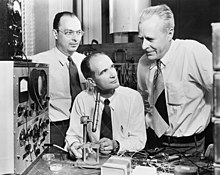Fichier:Bell telephone magazine (1922) (14755881622).jpg

Fichier d’origine (2 072 × 1 642 pixels, taille du fichier : 1,27 Mio, type MIME : image/jpeg)
Ce fichier et sa description proviennent de Wikimedia Commons.
Description
| DescriptionBell telephone magazine (1922) (14755881622).jpg |
English: Photo of (left to right) John Bardeen, William Shockley and Walter Brattain, 1948. This is one of a series of publicity photos produced by Bell Labs prior to the public announcement of the invention of
the transistor (June 30, 1948). Although Shockley was not involved in the invention, and has never been listed on patent applications, Bell Labs decided that he must appear on all publicity photos along with Bardeen and Brattain. Shockley's Nobel Prize contribution - theory of a junction transistor - was separate from the Bardeen-Brattain work. Русский: Джон Бардин, Уильям Шокли, Уолтер Браттейн. Рекламное фото Bell Labs, приуроченное к публичному объявлению об изобретении первого (точечного) транзистора 30 июня 1948 года. Шокли не участвовал в изобретении, но компания решила, что он должен присутствовать на всех официальных фото изобретателей рядом с Бардином и Браттейном.
English: Identifier: belltelephonevol3132mag00amerrich (find matches) |
| Date | |
| Source |
https://www.flickr.com/photos/internetarchivebookimages/14755881622/ |
| Auteur | Internet Archive Book Images |
| Autorisation (Réutilisation de ce fichier) |
At the time of upload, the image license was automatically confirmed using the Flickr API. For more information see Flickr API detail. |
| Autres versions |
 |
| Flickr tags InfoField |
|
| Flickr posted date InfoField | 27 juillet 2014 |
Conditions d’utilisation
Cette image est issue de la collection The Commons du site Flickr. Les organismes y partageant leur collection déclarent qu'à leur connaissance, aucune restriction de droit d'auteur ne fait obstacle à leur diffusion, pour l'une des raisons suivantes : No known copyright restrictionsNo restrictionshttps://www.flickr.com/commons/usage/false
La page https://flickr.com/commons/usage/ donne à ce sujet plus d'informations. Merci d'ajouter des bandeaux de licence supplémentaires à cette image si des informations plus spécifiques sont disponibles à propos du statut de cette image. Consultez Commons:À propos des licences pour plus d'informations. |
| Public domainPublic domainfalsefalse |
Cette œuvre est dans le domaine public car elle a été publiée aux États-Unis entre 1929 et 1977 inclus, sans indication de copyright. À moins que son auteur ne soit mort depuis suffisamment longtemps, elle n'est pas dans le domaine public dans les pays ou régions qui n'appliquent pas la règle du terme le plus court pour les travaux provenant des États-Unis, comme le Canada (cinquante ans pma), la Chine continentale (cinquante ans pma, Hong Kong et Macao exclus), l'Allemagne (soixante-dix ans pma), le Mexique (cent ans pma), la Suisse (soixante-dix ans pma) et d'autres pays signataires d'accord bilatéraux. Voir cette page pour de plus amples explications.
العربية ∙ беларуская (тарашкевіца) ∙ čeština ∙ Deutsch ∙ Ελληνικά ∙ English ∙ español ∙ français ∙ Bahasa Indonesia ∙ italiano ∙ 日本語 ∙ 한국어 ∙ македонски ∙ Nederlands ∙ português ∙ русский ∙ sicilianu ∙ slovenščina ∙ ไทย ∙ Tiếng Việt ∙ 中文(简体) ∙ 中文(繁體) ∙ +/− |
| Cette image a été originellement postée sur Flickr par Internet Archive Book Images à l'adresse https://flickr.com/photos/126377022@N07/14755881622. Elle a été passée en revue le 17 septembre 2015 par le robot FlickreviewR, qui a confirmé qu'elle se trouvait sous licence No known copyright restrictions. |
17 septembre 2015
Légendes
Éléments décrits dans ce fichier
dépeint
Valeur sans élément de Wikidata
image/jpeg
c8d32eeb10d2cc5f4d17c63aa0dddfa24f3c4f18
1 331 453 octet
1 642 pixel
2 072 pixel
Historique du fichier
Cliquer sur une date et heure pour voir le fichier tel qu'il était à ce moment-là.
| Date et heure | Vignette | Dimensions | Utilisateur | Commentaire | |
|---|---|---|---|---|---|
| actuel | 18 septembre 2015 à 01:24 |  | 2 072 × 1 642 (1,27 Mio) | Fæ | == {{int:filedesc}} == {{subst:chc}} {{information |description={{en|1=<br> '''Identifier''': belltelephonevol3132mag00amerrich ([https://commons.wikimedia.org/w/index.php?title=Special%3ASearch&profile=default&fulltext=Search&search=insource%3A%2Fbell... |
Utilisation du fichier
La page suivante utilise ce fichier :

